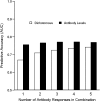Antibodies to Plasmodium falciparum antigens predict a higher risk of malaria but protection from symptoms once parasitemic
- PMID: 21628654
- PMCID: PMC3105040
- DOI: 10.1093/infdis/jir223
Antibodies to Plasmodium falciparum antigens predict a higher risk of malaria but protection from symptoms once parasitemic
Abstract
Background: Associations between antibody responses to Plasmodium falciparum antigens and protection against symptomatic malaria have been difficult to ascertain, in part because antibodies are potential markers of both exposure to P. falciparum and protection against disease.
Methods: We measured IgG responses to P. falciparum circumsporozoite protein, liver-stage antigen 1, apical-membrane antigen 1 (AMA-1), and merozoite surface proteins (MSP) 1 and 3, in children in Kampala, Uganda, and measured incidence of malaria before and after antibody measurement.
Results: Stronger responses to all 5 antigens were associated with an increased risk of clinical malaria (P < .01) because of confounding with prior exposure to P. falciparum. However, with use of another assessment, risk of clinical malaria once parasitemic, stronger responses to AMA-1, MSP-1, and MSP-3 were associated with protection (odds ratios, 0.34, 0.36, and 0.31, respectively, per 10-fold increase; P < .01). Analyses assessing antibodies in combination suggested that any protective effect of antibodies was overestimated by associations between individual responses and protection.
Conclusions: Using the risk of symptomatic malaria once parasitemic as an outcome may improve detection of associations between immune responses and protection from disease. Immunoepidemiology studies designed to detect mechanisms of immune protection should integrate prior exposure into the analysis and evaluate multiple immune responses.
Figures


Comment in
-
Adjusting for heterogeneity of malaria transmission in longitudinal studies.J Infect Dis. 2011 Jul 1;204(1):1-3. doi: 10.1093/infdis/jir225. J Infect Dis. 2011. PMID: 21628650 Free PMC article. No abstract available.
-
Effect of the pre-erythrocytic candidate malaria vaccine RTS,S/AS01E on blood stage immunity in young children.J Infect Dis. 2011 Jul 1;204(1):9-18. doi: 10.1093/infdis/jir222. J Infect Dis. 2011. PMID: 21628653 Free PMC article. Clinical Trial.
-
Antibodies to Plasmodium falciparum antigens and the risk of clinical malaria in endemic populations.Expert Rev Anti Infect Ther. 2011 Nov;9(11):987-91. doi: 10.1586/eri.11.128. Expert Rev Anti Infect Ther. 2011. PMID: 22029518
References
-
- Cohen S, Mc GI, Carrington S. Gamma-globulin and acquired immunity to human malaria. Nature. 1961;192:733–7. - PubMed
-
- Sabchareon A, Burnouf T, Ouattara D, et al. Parasitologic and clinical human response to immunoglobulin administration in falciparum malaria. Am J Trop Med Hyg. 1991;45:297–308. - PubMed
-
- Belizario VY, Saul A, Bustos MD, et al. Field epidemiological studies on malaria in a low endemic area in the Philippines. Acta Trop. 1997;63:241–56. - PubMed
Publication types
MeSH terms
Substances
Grants and funding
LinkOut - more resources
Full Text Sources
Research Materials

